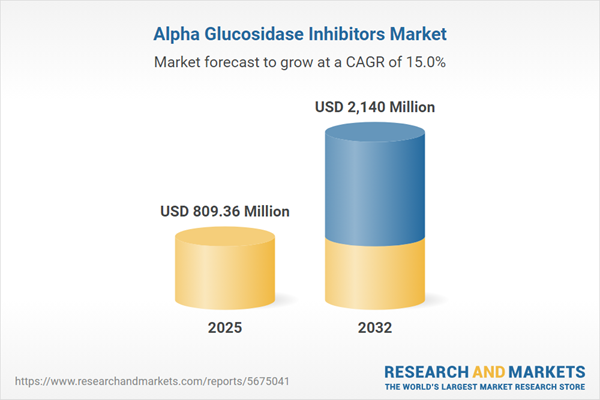Speak directly to the analyst to clarify any post sales queries you may have.
Senior leaders evaluating the alpha-glucosidase inhibitors market face an environment shaped by shifting therapies, regulatory changes, and technology-focused diabetes solutions. For robust decision-making and strategic adaptation, actionable market intelligence is essential.
Market Snapshot: Alpha-Glucosidase Inhibitors Market Trends
The alpha-glucosidase inhibitors market demonstrated notable growth in 2024, generating revenues of USD 703.76 million, with projections indicating expansion to USD 809.36 million in 2025 and the potential to reach USD 2.14 billion by 2032, marking a 14.96% CAGR. This upward trajectory is driven by medical advances in enzyme-based therapies, growing demand for digital tools in diabetes management, and increased adoption of remote patient monitoring technologies that facilitate active patient engagement and real-time efficacy tracking. Developed regions remain market leaders due to established healthcare infrastructures, while emerging regions benefit from strengthened healthcare capabilities and improvement in care accessibility. Companies are responding to evolving reimbursement models to strengthen competitive positions amid global regulatory shifts.
Scope & Segmentation of the Alpha-Glucosidase Inhibitors Market
- Product Type: Acarbose, miglitol, and voglibose, offered in branded and generic variants, address diverse procurement and clinical needs across healthcare settings.
- Dosage Form: Tablets, capsules, oral solutions, suspensions, and extended-release forms support practitioner flexibility in overcoming adherence barriers for multiple patient profiles.
- Distribution Channel: Hospital pharmacies, retail venues, and online distributors ensure consistent supply, reaching both centralized and remote care environments with logistical efficiency.
- Treatment Modality: Options for monotherapy or combination therapy provide tailored solutions for patients with varying comorbidities and pharmacological requirements.
- Patient Age Group: Customizable regimens accommodate adult, pediatric, and elderly patients, with clinical approaches refined to meet safety and efficacy needs by demographic.
- Regional Coverage: Comprehensive presence in established and high-growth regions, including the Americas, Europe, Asia-Pacific, the Middle East, and Africa. Key healthcare policy influencers are the United States, Germany, China, India, Brazil, and the UAE, each driving opportunities through evolving payer and regulatory strategies.
- Leading Companies: Major players—Bayer AG, Pfizer Inc., Novartis AG, Sanofi S.A., Takeda Pharmaceutical Company Limited, Bristol-Myers Squibb Company, Dr. Reddy’s Laboratories Limited, Astellas Pharma Inc., Zydus Cadila Limited, and Teva Pharmaceutical Industries Limited—integrate research, compliance, and commercial expertise to impact market evolution.
Key Takeaways for Senior Leaders
- Personalized therapy and the availability of extended-release formulations help address differentiated treatment objectives, enabling clinicians to optimize care for children and older adults.
- Incorporating digital health and remote patient monitoring augments patient outcome measurement and facilitates more responsive clinical management cycles.
- Collaborations between pharmaceutical and biotech companies accelerate development pipelines and expand market presence in under-served patient populations.
- Ongoing research targeting next-generation enzyme therapies and integrated drug regimens broadens pathways for comprehensive diabetes care.
- Building operational resilience requires agile responses to changing reimbursement systems, ensuring business continuity as payer mechanisms transform.
- Adapting to payer model shifts remains critical for sustained growth, particularly in a dynamically regulated sector.
Tariff Impact and Supply Chain Dynamics
Upcoming U.S. tariff changes projected for 2025 are motivating alpha-glucosidase inhibitor manufacturers to refine global supply chains. Strategies include increasing local production, diversifying sourcing partners, and employing hybrid procurement methods to mitigate regulatory and financial exposure. Greater industry collaboration with government entities and participation in incentives further support supply chain stability as commercial environments evolve.
Methodology & Data Sources
This analysis is grounded in peer-reviewed clinical trials, regulatory filings, validated industry data, and direct input from endocrinology experts and pharmaceutical executives, guaranteeing actionable insights.
Why This Report Matters
- Delivers a framework for leveraging digital health advancements and for managing multifaceted global regulations in the alpha-glucosidase inhibitors market.
- Supports targeted product positioning, ensuring engagement with essential stakeholders for broad, sustainable commercial impact.
- Facilitates strategic portfolio alignment with evolving clinical guidelines and reimbursement landscapes.
Conclusion
This report enables senior executives to proactively manage shifts within the alpha-glucosidase inhibitors sector. Adaptive planning, underpinned by reliable intelligence, is essential for future-ready decision-making.
Additional Product Information:
- Purchase of this report includes 1 year online access with quarterly updates.
- This report can be updated on request. Please contact our Customer Experience team using the Ask a Question widget on our website.
Table of Contents
3. Executive Summary
4. Market Overview
7. Cumulative Impact of Artificial Intelligence 2025
Companies Mentioned
The companies profiled in this Alpha Glucosidase Inhibitors market report include:- Bayer AG
- Pfizer Inc.
- Novartis AG
- Sanofi S.A.
- Takeda Pharmaceutical Company Limited
- Bristol-Myers Squibb Company
- Dr. Reddy's Laboratories Limited
- Astellas Pharma Inc.
- Zydus Cadila Limited
- Teva Pharmaceutical Industries Limited
Table Information
| Report Attribute | Details |
|---|---|
| No. of Pages | 189 |
| Published | November 2025 |
| Forecast Period | 2025 - 2032 |
| Estimated Market Value ( USD | $ 809.36 Million |
| Forecasted Market Value ( USD | $ 2140 Million |
| Compound Annual Growth Rate | 14.9% |
| Regions Covered | Global |
| No. of Companies Mentioned | 11 |









